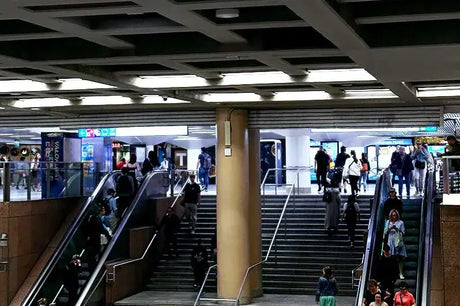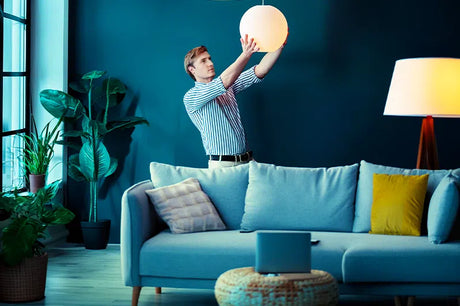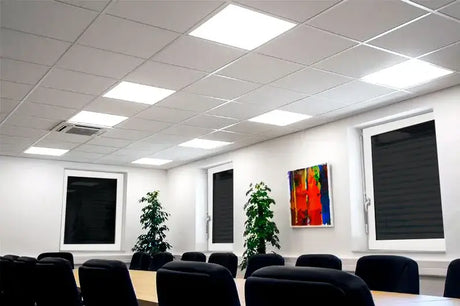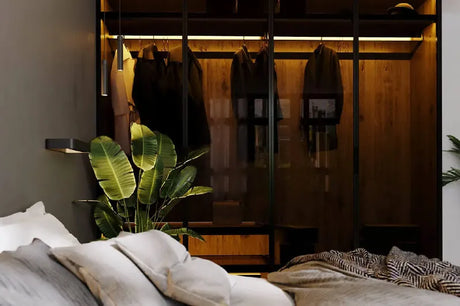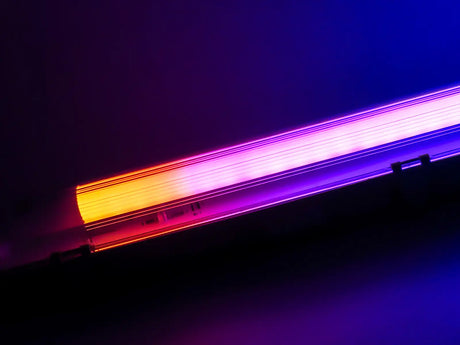In our digital world, blue light surrounds us constantly. Smartphones, tablets, laptops, TVs - they all emit blue light, which is beneficial during the day but can disrupt our sleep at night. Blue light suppresses the production of melatonin, the sleep hormone.
But there is hope! Red light has been shown to have a calming effect. It does not suppress melatonin production and can even help you fall asleep faster and improve sleep duration.
In this blog post, we will discuss:
- The harmful effects of blue light on our sleep
- How red light can help you sleep better
- The benefits of RGB LED lamps with red light
- Tips for using red light for better sleep
1. The Dangers of Blue Light
Blue light is a visible form of light with a wavelength of 400-490 nanometers (nm). It occurs naturally in sunlight but is also emitted in large amounts by electronic devices such as smartphones, tablets, computers, and TVs.
Consequences of too much blue light:
- Disruption of the circadian rhythm: Blue light suppresses the production of melatonin, the hormone that helps our bodies fall asleep. Too much exposure to blue light, especially in the evening hours, can lead to sleep problems such as difficulty falling asleep, reduced sleep quality, and increased daytime fatigue.
- Eye problems: Long-term exposure to blue light can lead to digital eye strain, which can cause symptoms such as blurred vision, dry eyes, headaches, and neck pain.
- Increased risk of chronic diseases: Research suggests that too much exposure to blue light may play a role in the development of chronic diseases such as diabetes, heart disease, and cancer.
Benefits of blue light:
- Increased alertness and cognitive function: Blue light can improve alertness, concentration, and memory.
- Improved mood: Blue light can improve mood and reduce symptoms of depression.
- Blood pressure regulation: Blue light can help regulate blood pressure.
- Treatment of winter depression: Blue light therapy can be an effective treatment for winter depression (seasonal affective disorder).
Tips for reducing blue light exposure:
- Limit the use of electronic devices in the evening hours.
- Use a blue light filter on your devices.
- Wear blue light glasses.
- Spend more time outdoors in natural light.
2. The Benefits of Red Light
Red light, with a wavelength of 630-680nm, has a unique set of effects on our bodies. In this comprehensive text, we will discuss the advantages and disadvantages of red light for health.
Benefits of red light:
1. Improved sleep:
- Fall asleep faster: Red light stimulates the production of melatonin, the sleep hormone, helping you fall asleep faster.
- Deeper, more relaxing sleep: Studies show that red light improves the depth and quality of sleep, leading to more energy and better mental focus during the day.
- Reduced stress and anxiety: Red light can reduce stress and anxiety by calming the sympathetic nervous system.
2. Improved wound healing:
- Stimulates collagen production: Red light stimulates the production of collagen, an important protein that promotes wound healing.
- Reduces inflammation: Red light has anti-inflammatory effects that can promote the healing of wounds and tissue damage.
3. Increased energy and muscle performance:
- Stimulates mitochondrial function: Red light can increase energy production in cells by stimulating mitochondrial function.
- Improves muscle performance: Studies show that red light can improve muscle performance by increasing muscle endurance and reducing muscle soreness.
4. Improved skin condition:
- Reduces wrinkles and fine lines: Red light stimulates collagen production and can improve skin elasticity.
- Reduces acne: Red light has antibacterial properties that can fight acne-causing bacteria.
Disadvantages of red light:
- Eye damage: Although red light is generally safe, too much exposure to red light can damage the eyes. It is important to pay attention to the intensity and duration of red light exposure.
- Disruption of the circadian rhythm: Exposure to red light at the wrong times of the day can disrupt the circadian rhythm. It is recommended to use red light in the evening hours to promote sleep.
- Interactions with medications: Red light can interact with certain medications. Consult your doctor if you are taking medication before using red light therapy.
Applications of red light:
Red light therapy can be applied in various ways, including:
- Red light LED lamps (RGB): These lamps can be used to illuminate a specific space with red light.
- LED therapy panels: These panels can be used to illuminate the body with red light.
- Red light glasses: These glasses can be worn to illuminate the eyes with red light.
3. RGB LED Lamps: The Perfect Solution
Traditional lamps only offer white light, which is not ideal for the evening hours. RGB LED lamps offer a smart solution: they can produce different colors of light, including red!
Advantages of RGB LED lamps:
- Choose the desired color light for each moment
- Create a relaxing atmosphere in the evening
- Reduce your exposure to blue light
- Save on energy costs
4. Tips for Using Red Light
1. Choose the Right Time:
- Use red light in the evening, 1-2 hours before bedtime. This helps promote melatonin production and prepares your body for sleep.
- Avoid exposure to red light in the morning or afternoon, as this can disrupt your circadian rhythm.
2. Choose the Right Lamp:
- Opt for a lamp with a wavelength of 630-680nm. This is the wavelength most effective for promoting sleep.
- Pay attention to the lamp's intensity. Too much red light can cause eye damage. Start with a low intensity and gradually increase it.
- Make sure the lamp has a timer so you can control the duration of exposure.
3. Determine the Optimal Exposure Time:
- Start with a short exposure time of 10-15 minutes.
- Gradually increase the exposure time to 30-60 minutes per day.
- Listen to your body. If you feel sleepy, stop the exposure.
4. Combine Red Light with Other Relaxation Techniques:
- Combine red light with other relaxation techniques, such as reading, meditation, or yoga.
- This can enhance the effect of red light on sleep and help you relax and fall asleep.
5. Create a Routine:
- Use red light at a consistent time in the evening to create a routine.
- This helps your body get accustomed to the effects of red light and can improve sleep quality.
6. Be Patient:
- It may take some time to notice the benefits of red light on sleep.
- Be patient and keep following the tips in this blog post.
Additional Tips:
- Use red light in a dark room to achieve maximum effect.
- Wear an eye mask to prevent light from entering your eyes.
- Ensure a comfortable temperature in the bedroom.
- Avoid using electronic devices in the bedroom.
- By following these tips, you can maximize the benefits of red light for sleep and enjoy a better night's rest.
5. Conclusion
Red light is a powerful tool that can help you sleep better. By using RGB LED lamps, you can experience the benefits of red light and enjoy a better night's sleep.
Sources:
https://www.ncbi.nlm.nih.gov/pmc/articles/PMC4377712/
Additional Information:
For more information on the effects of light on our health, you can visit the website of the Netherlands Brain Institute: https://www.herseninstituut.nl/
Disclaimer:
This blog post is for informational purposes only and should not be considered medical advice. Always consult a doctor if you have sleep problems.




